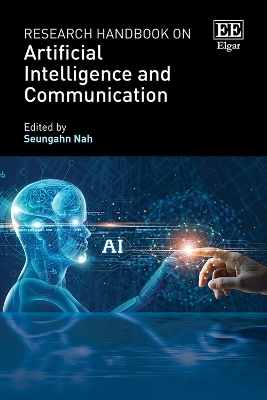
Research Handbook on Artificial Intelligence and Communication
Edward Elgar Publishing Ltd (Verlag)
978-1-80392-029-0 (ISBN)
The team of expert contributors explore key conceptual, theoretical and methodological approaches and examine a variety of ethical considerations, legal issues and policy implications of AI across diverse contexts. The Handbook spans a wide range of topics related to AI-empowered, immersed, mediated and integrated communications. These range from the role of news media and digital communication platforms in constructing, representing and framing AI across different countries and cultures, to the public understanding of, attitude towards and interaction with AI and its related technologies. Offering foundational guidance on AI and communication, the Research Handbook will stimulate further intellectual inquiry for future scholarship in this rapidly evolving area.
Cross-disciplinary in scope, this dynamic Research Handbook will prove an essential reference for students and scholars in multiple fields, including communication, computer science, data and information science, sociology, business, and education. Policymakers and practitioners will also find it a valuable resource to help inform AI-related regulations and policies.
Edited by Seungahn Nah, Professor, Inaugural Dianne Snedaker Chair in Media Trust and Research Director, Consortium on Trust in Media and Technology, College of Journalism and Communications, University of Florida, US
Contents:
Preface xvi
Introduction to the Research Handbook on Artificial Intelligence and Communication xvii
Seungahn Nah
PART I MAPPING RESEARCH ON ARTIFICIAL INTELLIGENCE AND COMMUNICATION
1 A systematic review of scholarship in AI and communication research (1990–2022) 2
Sumita Louis and Seungahn Nah
2 AI-integrated communication: conceptualization and a critical review 29
Donghee Yvette Wohn and Mashael Almoqbel
3 Toward a sociology of machines: an interviewing methodology for human–machine communication 44
Cait Lackey
4 Discovering developmental trajectories and trends of conversational agent research using dynamic topic modeling 58
Hüseyin Özçinar and Aylin Sabanci Bayramoğlu
5 A systematic review of scholarship on metaverse 79
Jun Luo, Sumita Louis, and Seungahn Nah
PART II FRAMING ARTIFICIAL INTELLIGENCE
6 AI in schools and universities: mapping central debates through enthusiasms and concerns 94
Kristjan Kikerpill and Andra Siibak
7 How news organizations and journalists understand artificial intelligence: application of news language database to AI-related news stories 108
Jeongsub Lim
8 AI in Portugal: news framing, tone, and sources 125
Paulo Nuno Vicente
9 AI bias, news framing, and mixed-methods approach 145
Jun Luo, Seungahn Nah, and Jungseock Joo
PART III PUBLIC UNDERSTANDING OF ARTIFICIAL INTELLIGNECE
10 Risk perceptions and trust mechanisms related to everyday AI 163
Hichang Cho and Rosalie Hooi
11 Fearing the future: examining the conditional indirect correlation of attention to artificial intelligence news on artificial intelligence attitudes 176
Alex Kirkpatrick, Jay D. Hmielowski, and Amanda Boyd
12 A machine-learning approach to assessing public trust in AI-powered technologies 193
Poong Oh and Younbo Jung
13 Machine learning and deep learning for social science: a bibliometric approach 214
Jang Hyun Kim and Dongyan Nan
14 AI and data-driven political communication (re)shaping citizen–government interactions 231
Jérôme Duberry
15 AI folk tales: how nontechnical publics make sense of artificial intelligence 246
Barbara Pohl and Lauri Goldkind
PART IV INTERACTING WITH ARTIFICIAL INTELLIGENCE
16 Facilitating stakeholder communication around AI-enabled systems and business processes 268
Matthew Bundas, Chasity Nadeau, Thanh H. Nguyen, Jeannine Shantz, Marcello Balduccini, Edward Griffor, and Tran Cao Son
17 The levels of automation and autonomy in the AI-augmented newsroom: toward a multi-level typology of computational journalism 284
Hannes Cools, Baldwin Van Gorp, and Michaël Opgenhaffen
18 AI as communicative other: critical relationality in human–AI communication 300
Marco Dehnert
19 Needs and practices for AI-mediated messaging in uncertain circumstances 315
Adam M. Rainear, Patric R. Spence, and Kenneth A. Lachlan
20 Why wasn’t I ready for that? Suggestions and research directions for the use of machine agents in organizational life 325
Patric R. Spence
21 The Media Are Social Actors paradigm and beyond: theory, evidence, and future research 337
Kun Xu, Fanjue Liu, Xiaobei Chen, and Matthew Lombard
PART V POLICING ARTIFICIAL INTELLIGENCE
22 Evaluating the self-disclosure of personal information to AI-enabled technology 355
Jessica K. Barfield
23 To reimagine more deeply: understanding what AI communicates 376
John S. Seberger, Hyesun Choung, and Prabu David
24 Automated inequalities: examining the social implications of artificial intelligence in China 391
Bibo Lin and Joanne Kuai
25 Design + power: policy for the ecology of influence 405
Jasmine McNealy
Index 418
| Erscheinungsdatum | 16.11.2023 |
|---|---|
| Verlagsort | Cheltenham |
| Sprache | englisch |
| Maße | 156 x 234 mm |
| Themenwelt | Informatik ► Theorie / Studium ► Künstliche Intelligenz / Robotik |
| Sozialwissenschaften ► Kommunikation / Medien ► Kommunikationswissenschaft | |
| Sozialwissenschaften ► Kommunikation / Medien ► Medienwissenschaft | |
| ISBN-10 | 1-80392-029-7 / 1803920297 |
| ISBN-13 | 978-1-80392-029-0 / 9781803920290 |
| Zustand | Neuware |
| Haben Sie eine Frage zum Produkt? |
aus dem Bereich


